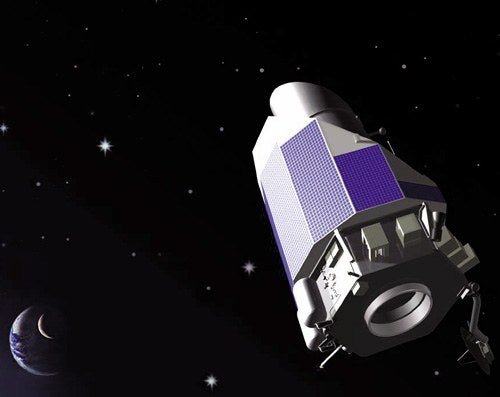For nearly a decade, University of California at Berkeley astronomer Geoff Marcy and his colleagues have been using the W. M. Keck telescopes to discover giant planets orbiting distant stars. Now, with the successful launch of NASA’s Kepler mission, they will be using Keck I’s 10-meter astronomical eye to discover distant Earths. Kepler will pick out earthlike candidates. Keck will then zero in on them and determine if they are at all similar to our planet.
Visit Astronomy.com’s Kepler mission page for ongoing coverage including news and editors blogs.
“Keck and NASA have a long-standing partnership to push astronomy research to its fullest potential,” said Taft Armandroff, the director of Keck Observatory headquartered in Kamuela, Hawaii. “This Keck-Kepler collaboration gives that partnership a compelling new scientific focus.”
Kepler was launched from NASA’s Kennedy Space Center March 6. Aboard the spacecraft is an 84-megapixel camera that will focus on a single region of the sky. It will snap repeated images of 100,000 stars, looking for those that dim periodically. By studying the stars’ episodic decreases in starlight, astronomers will be able to determine the diameter of the object that passes in front of the star, blocks its light, and causes the dimming.
“Kepler does not tell astronomers with certainty if the object taking a bite out of the starlight is a planet or another star,” said Marcy. “That is where Keck plays a crucial role to the Kepler mission.” He, along with a large international planet-hunting team, has discovered nearly half of the 300-plus known planets outside the solar system.
Astronomers call the objects Kepler detects transits because the planet candidate seems to eclipse its parent star’s light. The phenomenon is similar to the Moon eclipsing the Sun during a total solar eclipse. But a distant planet eclipsing its parent star will only block a small fraction, 1/10,000, of the star’s light. The Moon, by contrast, blocks nearly all of the Sun’s light in a total solar eclipse.
In the Kepler-Keck duo, once Kepler team members find an Earth candidate and determine that they’re not looking at two stars orbiting each other, they will hand the object off to Marcy and his colleagues. The team will use the Keck I Telescope and the High Resolution Spectrometer (HIRES) to monitor how the light coming from the parent star changes as the planet candidate orbits.
HIRES is an instrument that spreads light collected from the telescope mirrors into its component wavelengths or colors. This is called a spectrum. When the planet candidate orbits around the back of the star, its gravity will pull ever so slightly on the star causing the star’s spectrum to shift toward redder wavelengths.
When the planet comes around in its orbit to cross the face of the star, it will pull the star in the other direction, and the star’s spectrum will shift toward bluer wavelengths.
HIRES will detect these shifts and give astronomers the star’s radial velocity, or the speed at which the star moves toward or away from Earth. Based on this speed, Marcy and his team will be able to calculate the planet candidate’s mass.
“Keck’s HIRES is the only game in town that can measure spectral shifts caused by an Earth-sized planet,” said Marcy. “No other telescope is big enough. That is why NASA is really heavily dependent on the Keck telescopes right now.”
Calculating the planet candidate’s mass is important because it tells astronomers whether a planet or another star is eclipsing the parent star. If the object turns out to be a planet, Marcy and his team can then use the Keck-calculated mass and Kepler-calculated diameter to determine the planet’s density. “In a sense, it’s as if we are taking the planets and dunking them in a bathtub to see if they float,” Marcy said. “A rocky planet like Earth would sink.” Earth has a density of about 5 grams per cubic centimeter. Gas giants, on the other hand, have a density close to water at about 1 gram per cubic centimeter.
“Studying the radial velocity of the planet candidates Kepler discovers is a key endeavor in understanding our place in the cosmos,” Armandroff said. “It will help answer one of humanity’s biggest questions, Are we alone?”
Marcy and his colleagues plan to start studying Kepler’s candidate Earths with Keck I and HIRES during the last three nights of July 2009.










